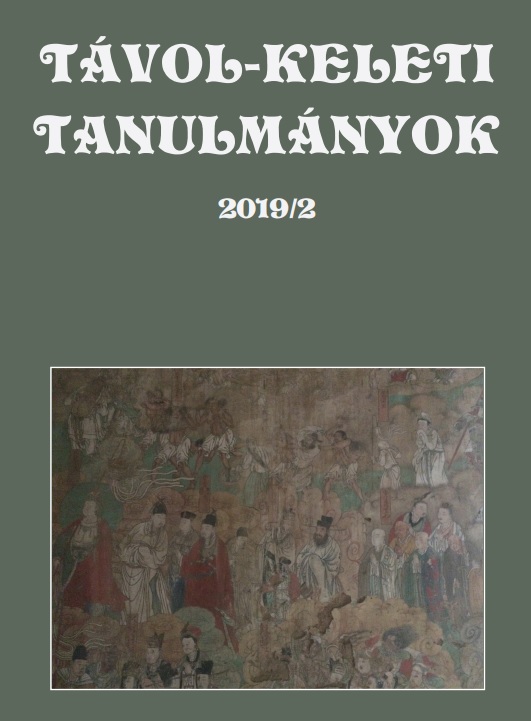Published 2020-10-30
Keywords
- Dhammacakkappavattana-sutta,
- Chinese Buddhism,
- An Shigao,
- Kang Mengxiang,
- the wheel of Dhamma
How to Cite
Copyright (c) 2020 the author(s)

This work is licensed under a Creative Commons Attribution-NonCommercial 4.0 International License.
Abstract
In this paper I offer the Hungarian translation and commentary of a rather early Chinese translation of the Dhammacakkappavattana-sutta (‘Setting the Wheel of Dhamma in Motion’), one of the most important Buddhist suttas recounting the first sermon of the historical Buddha. This Chinese translation (T02n109: Fo shuo zhuan falun jing 佛說轉法輪經), slightly neglected in previous research, is traditionally attributed to An Shigao 安世高 (2nd c. AD), but I argue that, based on the terminological similarities between this scripture and the Zhong benqi jing 中本起經 (T196), Kang Mengxiang 康孟詳 (ca. 200 AD) would be a more plausible candidate for the authorship.
References
- Takakusu Junjirō 高楠順次郎 – Watanabe Kaigyoku 渡辺海旭 (eds.) 1924–32. Taishō shinshū daizōkyō 大正新脩大蔵経. 85 vols. Tōkyō: Taishō Issaikyō Kankōkai. [Online version: SAT Daizōkyō Text Database (SAT 大正新脩大蔵経テキストデ ータベース). 2015 version. University of Tokyo, http://21dzk.l.u-tokyo.ac.jp/SAT/ (utoljára megtekintve: 2019.07.20.)]
- A páli fordító csoport 2011. „SN 56.11 Dhammacakkappavattana Sutta. 1. A Dharma kerekének forgásba hozása.” Online elérhetőség: http://a-buddha-ujja.hu/Szutta/Samyutta-56-11-cs1 (utolsó megtekintés: 2019.07.01.)
- Anālayo 2012. „The Chinese Parallels to the Dhammacakkappavattana-sutta (1).” Journal of the Oxford Centre for Buddhist Studies 3: 12–46. [Online elérhetőség: http://www.jocbs.org/index.php/jocbs/article/view/25/39, utolsó megtekintés: 2019. június 28.]
- Anālayo 2013. „The Chinese Parallels to the Dhammacakkappavattana-sutta (2).” Journal of the Oxford Centre for Buddhist Studies 5: 9–41. [Online elérhetőség: http://jocbs.org/index.php/jocbs/article/view/53/85, utolsó megtekintés: 2019. június 28.]
- Anālayo 2017. „Dhammacakkappavattana-sutta”, In: K. T. S Sarao – J. D. Long (eds.): Encyclopedia of Indian Religions, Buddhism and Jainism. Dordrecht: Springer, 372–374. https://doi.org/10.1007/978-94-024-0852-2_905
- Bareau, André 1963. Recherches sur la biographie du Buddha dans les Sutrapitaka et les Vinayapitaka anciens. Vol. I : De la quête de l'Éveil à la conversion de Sâriputra et Maudgalyâyana. [PEFEO, vol. 53.] Paris: École française d'Extrême-Orient.
- Bodhi (Bkikkhu) 2000. The Connected Discourses of the Buddha: A Translation of the Saṃyutta Nikāya. Boston: Wisdom Publications.
- Buswell, Robert E., Jr. – Donald S. Lopez, Jr. (eds.) 2014. The Princeton Dictionary of Buddhism. Princeton, NJ: Princeton University Press. https://doi.org/10.1515/9781400848058
- Dessein, Bart 2007. „The First Turning of the Wheel of the Doctrine – Sarvāstivāda and Mahāsāghika Controversy.” In: Ann Heirman – Stephan Peter Bumbacher (eds.): The Spread of Buddhism. Leiden–Boston: Brill, 15–48. https://doi.org/10.1163/ej.9789004158306.i-474.6
- Dharmachakra Translation Committee 2013. The Play in Full: Lalitavistara. New York: 84000.
- Durt, Hubert 2008 [2010]. „Early Chinese Buddhist translations – Quotations from the early translations in anthologies of the sixth century.” Journal of the International Association of Buddhist Studies 31/1–2: 119–139.
- Forte, Antonino 1995. The Hostage An Shigao and his Offspring: an Iranian Family in China. Kyoto: Scuola di Studi sull'Asia Orientale.
- Horner, I. B. 1951/1982. The Book of the Discipline (Vinaya Piṭaka). Vol. IV. (Mahāvagga). London: Pali Text Society.
- Körtvélyesi Tibor 2018. A páli kánon egyes rétegei – szövegtörténeti és doktrinális vizsgálódások. ELTE BTK, Nyelvtudományi Doktori Iskola, PhD-disszertáció.
- Monier-Williams, Monier [rev. by E. Leumann, C. Cappeller et al.] 1899. A Sanskrit-English Dictionary: Etymologically and Philologically Arranged with Special Reference to Cognate Indo-European languages. Oxford: Clarendon Press.
- Nattier, Jan 2008. A Guide to the Earliest Chinese Buddhist Translations: Texts from the Eastern Han 東漢 and Three Kingdoms 三國 Periods. Tokyo: The International Research Institute for Advanced Buddhology, Soka University.
- Sastri, N. A. 1938. „The First Sermon of the Buddha.” New Indian Antiquary 1/8: 473–492.
- Smith, Norman J. 2001. „The 17 Versions of the Buddha’s First Discourse.” [Online elérhetőség: https://ia600304.us.archive.org/22/items/The17VersionsOfTheBuddhasFirst
- Discourse/dhammacakka.pdf, utolsó megtekintés: 2019.07.06.]
- Soothill, William Edward – Hodous, Lewis 1977. A Dictionary of Chinese Buddhist Terms:
- with Sanskrit and English Equivalents and a Sanskrit-Pali Index. Delhi – Varanasi – Patna: Motilal Banarsidass [Eredeti kiadás: K. Paul, Trench, Trubner & Co., 1937].
- Tan Piya 2002/2010. „Dhamma,cakka Pavattana Sutta.” Online elérhetőség: http://www.themindingcentre.org/dharmafarer/wp-content/uploads/2009/12/1.1-Dhammacakka-Pavattana-S-s56.11-piya.pdf (Utoljára megtekintve: 2019.07.01.)
- Vekerdi József 1989. Buddha beszédei. Budapest: Helikon Kiadó.
- Zacchetti, Stefano, 1997. „Un problema di critica testuale nel Foshuo zhuan falun jing (Tl09) attribuito ad An Shigao.” Annali di Ca' Foscari, Rivista della Facolta di Lingue e Letterature Straniere de O'Universita di Venezia 36/3: 381–395.
- Zacchetti, Stefano 2010. „Defining An Shigao’s 安世高 Translation Corpus: The State of Art in Relevant Research.” Xiyu Lishi Yuyan Yanjiu Jikan 西域歷史語言研究集刊 3: 249–270.
- Zürcher, Erik 1977. „Late Han Vernacular Elements in the Earliest Buddhist Translations.” Journal of Chinese Language Teachers Association 12: 177–203. [Repr. in Jonathan A. Silk (ed.) Buddhism in China. Collected Papers of Erik Zürcher. Leiden–Boston: Brill, 27–61.]
- Zürcher, Erik 1991 [2013]. „A New Look at the Earliest Chinese Buddhist Texts.” In: Koichi Shinohara – Gregory Schopen (eds.): From Benares to Beijing: &says on Buddhism and Chinese Religion. Oakville: Mosaic Press, 277–304. [Repr. in: Jonathan A. Silk (ed.): Buddhism in China. Collected Papers of Erik Zürcher. Leiden–Boston: Brill, 419–446.]
- Zürcher, Erik 2007. The Buddhist Conquest of China. The Spread and Adaptation of Buddhism in Early Medieval China. [Sinica Leidensia, Vol. 11.] Leiden: Brill. [Eredeti kiadás: 1959. Leiden: Brill. 2 vols.]

